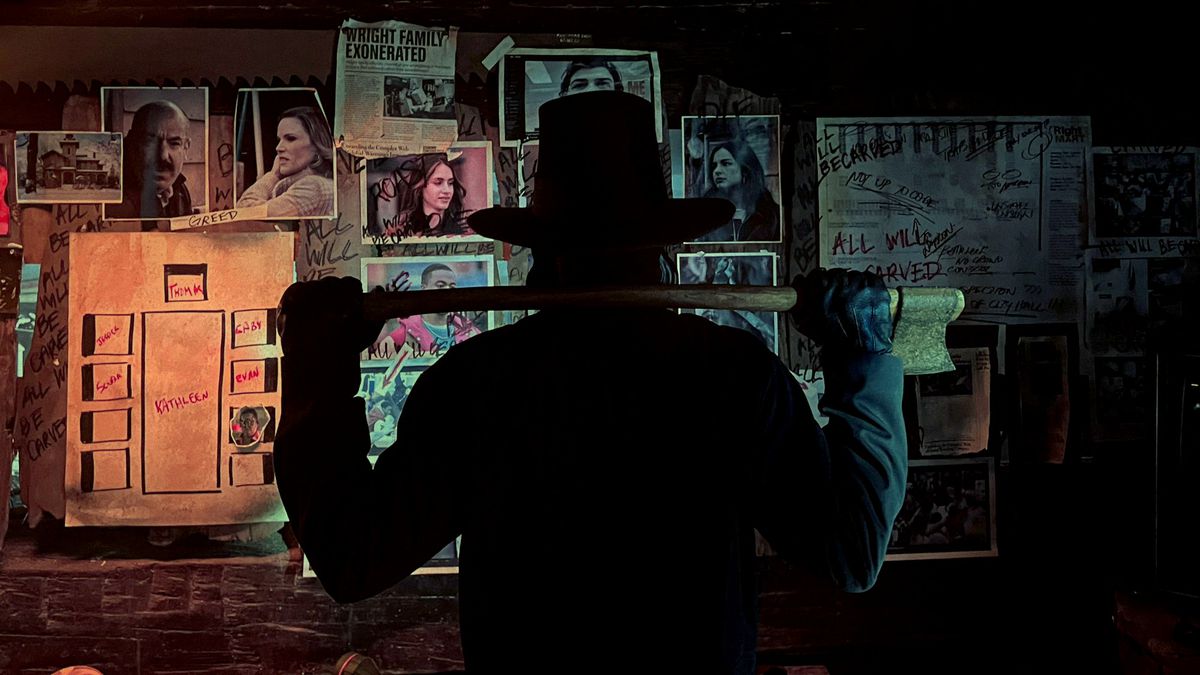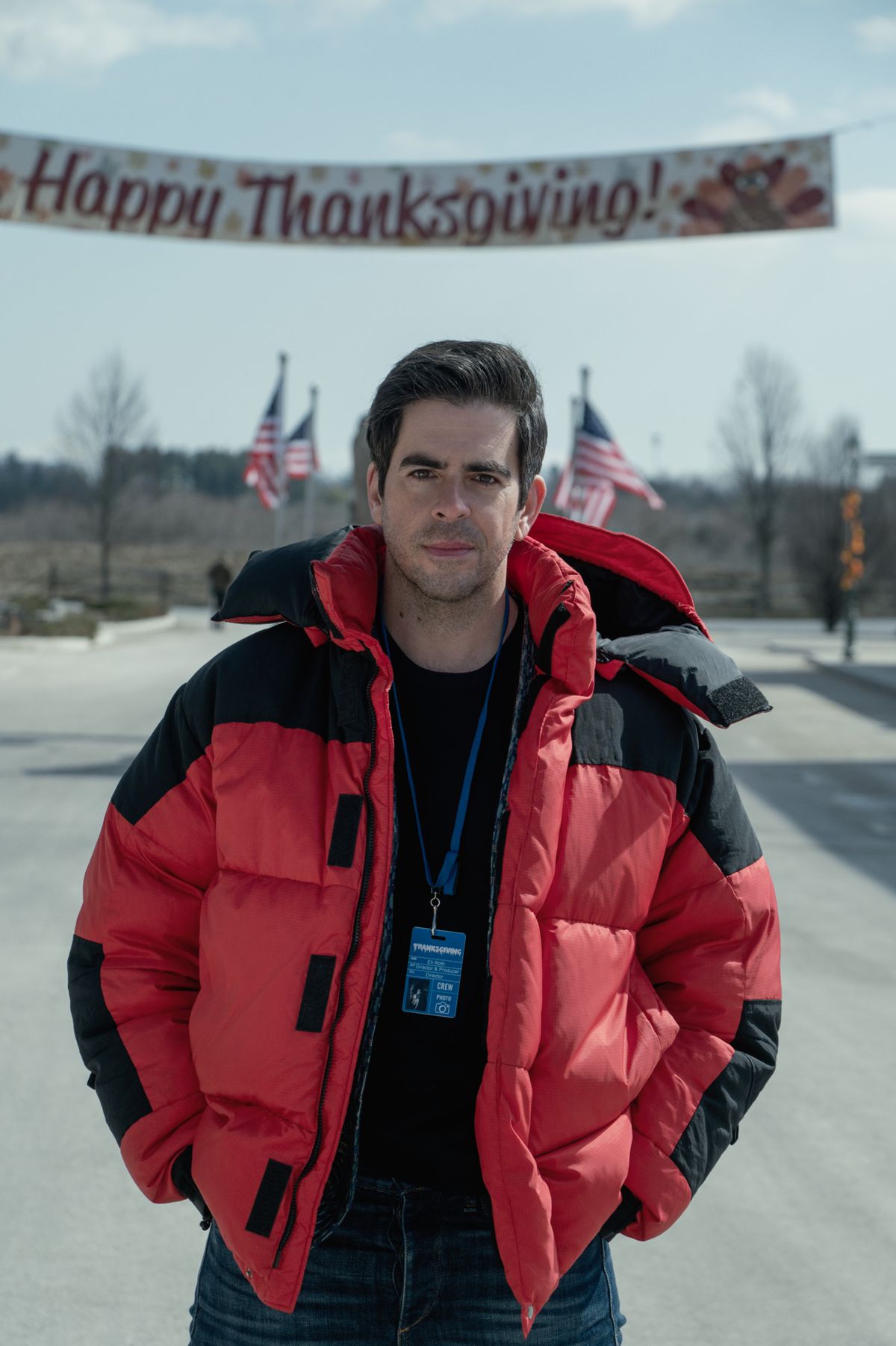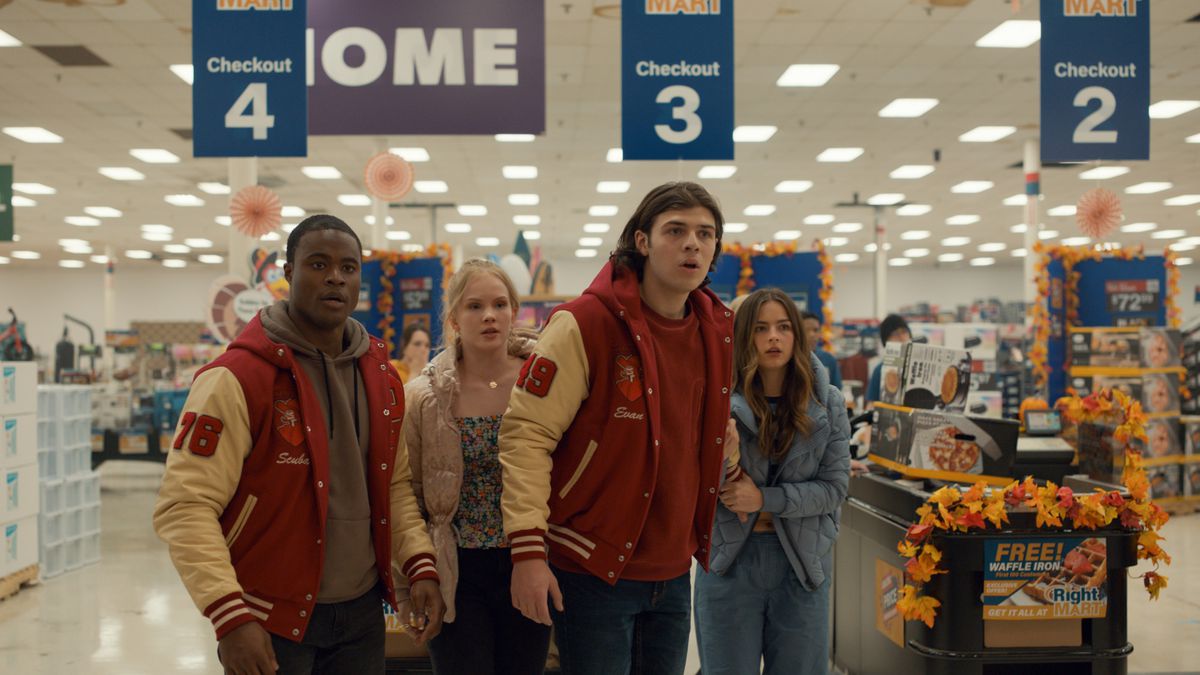There’s a correct method to jamming two corncob holders into a teenager’s ears for maximum terror. Eli Roth has known the way since he was a kid in Massachusetts, shooting horror movies in his backyard and coming up with kills that would eventually find their way into his new slasher, Thanksgiving, 40 years later. The gag is simple: Start with the corn picks tucked in the screen victim’s ear, yank them out at full-speed, and make sure the actor is screaming at the beginning and surprised at the end. When it’s all played in reverse, the practical effect looks absolutely gruesome — or, for a horror movie, perfect.
“It’s the cheapest gag in the world, but I love that stuff,” the director tells Polygon on a call ahead of Thanksgiving’s release. The movie is full of “that stuff” — grisly, campy, low-lift kills that sound like nightmares on paper, but are pure catnip when executed by a horror craftsman who revels in the limbo between horror and comedy. “I want the audience cackling and hiding their eyes, going, ‘I can’t believe they’re doing this! How much farther is this going to go?!’ And when I’m shooting it, I shoot everything.”
And he does mean everything. In Thanksgiving, one victim gets seasoned, basted, and roasted in an oven, then served for dinner. There’s no implication of fiery death — audiences get a whole mouthful of the convection execution. Eli Roth has returned.
Eli Roth will always have the reputation of a “horror guy,” even if cranial splatter is, today, only a fraction of his business. After Roth broke out with 2003’s unnervingly weird Cabin Fever, Hollywood wanted him to be that guy, and he happily accepted his role as a fresh-faced provocateur. When New York Magazine slammed his follow-up film, 2005’s Hostel, as “torture porn,” the myth of Roth calcified: He was a guy who would do anything to make the audience squirm.
His horror-movie martyrdom made him an obvious choice to direct a segment for Quentin Tarantino and Robert Rodriguez’s formally ambitious 2007 double-header Grindhouse. At the time, his contribution — a trailer for a fake horror movie called Thanksgiving — wasn’t the beginning of something, but the end. Ever since he and his childhood friend Jeff were 12 years old, they lamented that the horror movie release calendar all but dried up after Halloween.
“The rest of the year was just Christmas and family movies! And I’m Jewish, so Christmas movies don’t really matter to me. I would just have to wait until January or February for the movies to get good again,” he says. “So I wanted to fill the November void. There was a desert with no horror films. I wanted to fill it with a Thanksgiving slasher film.”

The Grindhouse trailer let Roth dump a series of ridiculous, violent ideas out of his head without the pain of writing a story around them — his trailer was just a plate full of gravy. After he shot that trailer for Tarantino and Rodriguez, there was never really talk of making a feature-length Thanksgiving. Roth moved on, both from the concept and from traditional horror. In the last decade, he’s dipped into disaster (Aftershock), martial arts (producing RZA’s The Man with the Iron Fists), thriller (Knock Knock), revenge (Death Wish), and spoopy kids fare (The House with a Clock in Its Walls). He even tackled a major video game adaptation (the upcoming Borderlands).
Netflix’s Hemlock Grove let Roth experiment with telling serialized horror-ish stories, and The Green Inferno allowed him to venture into B-movie cannibal pastiche. But after his run on Hostel and Hostel: Part II, the rebel version of Roth that everyone knew quietly moved on. Thanksgiving found him again, at age 51, and brought him back to where he started.
Roth sparked to the idea of turning Thanksgiving into a real movie when he started seeing Black Friday videos going viral online. “[Black Friday] is the perversion of the holiday,” he says. “It used to be about being thankful, and then all of a sudden, these Christmas sales ticked over into Black Friday, where the gates go up at midnight. Everyone’s so thankful at dinner, and then they try and kill each other for a PlayStation or flat-screen or a waffle iron.
“That’s what made us want to make the movie, thinking, Oh, this is what it’s about: It’s about consumerism run amok. It’s this idea of pretending to be thankful, but actually, like, stepping over your neighbor to get an item that’s on sale.”

Thanksgiving opens with a fatal Black Friday rampage at a Walmart-esque big-box store in Massachusetts. Roth unleashes wanton destruction laced with his signature dark comedy. One year later, a killer dons a mask — specifically, the visage of original Plymouth Pilgrim John Carver — to pick off people connected to the incident, and drench the state’s most sacred holiday in blood. Heads cave in, ligaments get chopped, and one person’s guts are creamed with an electric hand mixer. But not even the prudes would call it torture porn.
The critical conversations around his early work have not bruised Roth. These days, he feels vindicated. “Time is the only critic that matters,” he says. While on the press tour for Thanksgiving, he says he’s been talking to 20-somethings about their favorite horror movies, and his name constantly comes up. “They’re telling me that Hostel and Grindhouse are the single most influential horror films of the ’00s. Those are the movies that matter to them. They’re not thinking about the box-office bomb Grindhouse or torture-porn Hostel. They’re just like, ‘These are amazing movies that made such an impact in my life. They made me want to be a writer or filmmaker. I never forgot them.’”
But after walking away from more straightforward horror for the last decade, then returning in full force for Thanksgiving, Roth is aware of how he’s changed. “The fun was being the most shocking guy in the room 20 years ago, but I don’t need to be that anymore,” he says. “I just need to make a great movie.”
The director cites Malcolm Gladwell’s 10,000-hour theory when thinking about his own career arc. “If it takes 10,000 hours to master something, which is about eight hours a day for 10 years, and I’m in 20 years of directing — I feel like I’m approaching that place of mastery, where I’m constantly learning, but I know what I’m doing now.” Still, he adds, he’s trying to outdo that shocking guy from 20 years ago.
Roth spends a lot of our interview praising his crew. For Thanksgiving, he brought on production designer Peter Mihaichuk (Antibirth) to build out a quaint Massachusetts town ready for an array of over-the-top kills, and reunited with Hostel director of photography Milan Chadima to bring back some of the old mojo. (Chadima also shot second unit action on Borderlands.) Prosthetic designer Adrien Morot (The Whale) and his wife and collaborator, Kathy Tse, along with Steve Newburn (Beau Is Afraid), worked on all the goopy slasher effects, which Roth forcefully describes as “genius.” They all came together to nail Roth’s tone, which he wanted to bring away from “realistic, grueling endurance test” to “the Final Destination end of the spectrum.” When threaded through a big who’s-the-killer mystery, Thanksgiving plays like a Scream spinoff shot by Lucio Fulci.
Maybe the biggest tell that Roth isn’t the grungy provocateur of his youth is his willingness to test cuts of the movie on audiences and hone the edit based on reactions. Like Judd Apatow’s approach to precision comedy, Roth studies the data. For Thanksgiving, he teamed with Kevin Goetz of the research firm Screen Engine/ASI to track “what people were feeling” while watching cuts of the film, in order to finesse timing and shriek count.
“If they’re screaming, cackling, and applauding at the end of it, you’ve got them,” says Roth of his scientific process. “If you’ve pummeled them into silence and submission, that’s not good. It’s like when we’re eating our Thanksgiving dinner, we have a plateful of our favorite food, maybe we have another one, but if you go for thirds, you’re gonna have that lump in your stomach, you don’t want to look at food, you just want to go home and throw up. I don’t want that. I want people hungry all the way through dessert. So you just pull back. Too much of a good thing actually can ruin it.”

The Eli Roth of 2023 is an entertainer. His early films may have nestled their way into the cultural consciousness and stood the test of time, but it’s possible that was an accident. Now it’s the mission. He sees Thanksgiving as a major banger, maybe the potential beginning of a horror franchise, certainly a concept he’d love to return to if the box-office numbers work out. And at the same time, he wants fans 20 years from now coming up again to tell him that he rocked their socks off.
“A horror movie is like a bottle of perfume,” he says. “The first time you smell it, it’s really potent. But every time you open it, it loses its potency. A horror movie will never be as terrifying as that first time you see it. So the circumstances matter.
“And when you see it in a theater, with an audience, it’s the birth of something. It’s like seeing a live sports event where something amazing happens. It’s not the same as watching it on TV. You were there, and everyone for the rest of their lives can say, I was there at the first John Carver movie, when Thanksgiving came on. Nobody knew what it was. And I was there in a theater with a crowd, screaming because we didn’t know what was coming. And it was one of the best times I’ve ever had in my life. So that’s what matters to me, that someone comes up to me, and they go, ‘I saw Thanksgiving opening weekend in the theaters, and it was one of the best times of my life.’”
Next August, Roth will hit the promotional trail for Borderlands, a live-action adaptation of Gearbox’s punk sci-fi shooter. The movie has faced a fair share of behind-the-scenes drama, including a round of reshoots Roth handed off to one of his producers, Deadpool co-director Tim Miller. Roth waves off any concern about his continued involvement or enthusiasm for the project, calling it “one of the best experiences of [his] life.” But even more of a rush than taking a stab at adapting a famed game series was going from that big studio action movie to a horror movie with “1/10th the budget that was knocked out in 35 days.” Even for a filmmaker who’s eclipsed the 10,000 hours required for mastery, Thanksgiving served up its ticking-clock challenges, from a riot sequence shot in four days to a frosty diner-set kill hammered out in one night.
“It took all my 20 years of directing skill to be able to pull off those sequences,” Roth says. “You don’t get to do things twice. You can’t second-guess yourself. You’re just going on instinct and adrenaline and moving fast and furious.”
Roth spent the two decades after Hostel proving he wasn’t a one-note filmmaker, and could even do more than just his day job. His additional credits include producing the Baywatch movie for Dwayne Johnson and co-starring in Tarantino’s Inglourious Basterds. But when his breakthrough approach to a full-length version of Thanksgiving lured him back to horror, he happily accepted. He is a “horror guy,” and he’s thrilled to be one.
“It felt like I was getting back to my roots on this one. There’s a part of me that was thinking, Yeah, this is where I belong.”
Thanksgiving is out now in theaters.
- SEO Powered Content & PR Distribution. Get Amplified Today.
- PlatoData.Network Vertical Generative Ai. Empower Yourself. Access Here.
- PlatoAiStream. Web3 Intelligence. Knowledge Amplified. Access Here.
- PlatoESG. Carbon, CleanTech, Energy, Environment, Solar, Waste Management. Access Here.
- PlatoHealth. Biotech and Clinical Trials Intelligence. Access Here.
- Source: https://www.polygon.com/23963797/eli-roth-thanksgiving-interview



